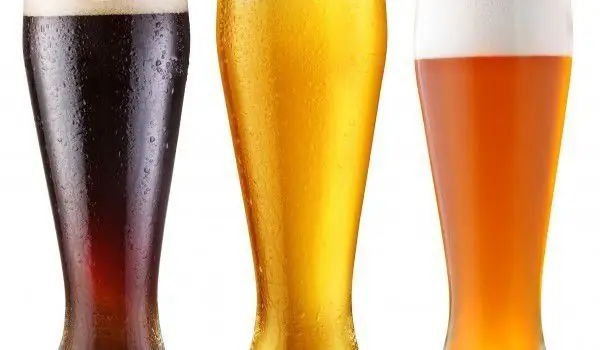2025 Author: Jasmine Walkman | [email protected]. Last modified: 2025-01-23 10:18
Beer is considered to be the oldest alcoholic beverage in the world. Today it is the third most popular beverage after coffee and tea. It is low in alcohol and is usually made from water, malt barley, hops and fermentation yeast. However, other flavors or sweeteners are often added to it. Other flavors can also be added through herbs and fruits.
History of beer
The first written document that testifies to the consumption and making of beer dates back to the Sumerian times, from the 4th century BC. Sumerian beer was called Sikaru. Even in those days the principle of production of beer was based on the fermentation of barley. The people of Babylon continued this tradition by grinding barley into flour and making bread-shaped molds from it.
This made them easier to transport. In fact, the production of beer and bread are deeply connected and begin at the same time. The custom required in the first month after the wedding the bride's father to drink beer for his son-in-law every day. Tradition required the groom to know that he could change the beer, but not the woman.
Beer is made by crushing this mold and immersing it in water to ensure long fermentation. Barley was one of the most common cereals and each family made its own beer according to a special recipe. Gradually, family production gave way to professional production. At the end of the 11th century, hops began to be added to beer, and so the taste we know today was obtained.
Beer gets much of its aroma mostly from hops, which is a plant with flowers that look more like cones than daisies. The alcohol came from the barley, which germinated and was then put into water to extract the sugar from it. This sugar becomes the basis for the development of miniature unicellular yeasts that "bloom" and secrete alcohol.

According to statistics of the Union of Brewers in Bulgaria, every Bulgarian drinks over 70 liters of beer a year. Our country ranks middle among European countries. The largest consumption is in Ireland - 160 liters, followed by the Czech Republic and Germany. Bulgaria is after France, Portugal and Italy.
Composition of beer
Beer contains many useful substances such as magnesium, potassium, phosphorus, iron, vitamins B and H, amino acids and others. Beer contains about 60 proteins, 40 of which are formed from yeast. It is believed that these proteins play a key role in the formation of beer foam.
Beer does not contain cholesterol and is low in sugar. The barley from which it is prepared is rich in easily digestible fiber, which improves the normal function of the intestine. Beer is a rich source of silicon, important for the strength of human bones.
Hops give not only flavor but also bitter taste to beer and is a great source of antioxidants. It is believed to be much more effective in preventing many diseases than red wine and green tea. The dark one beer is twice as rich in antioxidants as light.
Values of beer per 100 g
Calories29
Calories from fat 0
Total fat 0
Saturated fats 0
Polyunsaturated fats 0
Monounsaturated fats 0
Cholesterol 0
Sodium 4 mg
Potassium 21 mg
Total carbohydrates 1.64 g
Fiber 0
Zachary 0.09 g
Protein 0.24 g
Water 95 ml
Calcium 4 mg
Phosphorus 12 mg
Magnesium 5 mg

Selection and storage of beer
Choose beer in tightly closed bottles / glass and plastic /, which have a label with a clearly mentioned producer and expiration date. Store beer in a dark and cool place, and when it is already open - in the refrigerator. The long stay of the beer after opening its cap is not recommended, because with the entry of air it loses its carbonation and qualities.
Once you open the beer bottle, it cannot be stored for long. If it is well closed it can be kept for 2 days. Light is the biggest killer of beer because hops contain light-sensitive compounds known as isohumulones.
When the beer is exposed to light for a long time, a reaction forms in it. Isohumulones secrete compounds present in the skunk gland. This is the reason why beer is stored in green and brown bottles.
Beer in cooking
Beer is a pleasure as a drink, but its culinary application turns many dishes into unique creations. It is used to prepare a variety of dishes, sauces and marinades. If you soak the chicken in beerbefore you bake it, it will become incredibly tender. The same goes for roasting pork.
Beer combines very well with french fries and various hot appetizers. It goes great with meat, and dark beer is a great drink for the winter. In the hot summer months, beer consumption is highest, and its cooling effect makes it one of the most widely used beverages.
Benefits of beer
Even with the initial production of beer, people discovered the benefits and healing properties of it. Ancient Sumerian healers prescribed their patients to gnaw their mouths and drink hot beer for toothache.

During the Middle Ages, beer was used as a means of removing kidney stones and treating physical and spiritual exhaustion. When their feet were tired, people rubbed their feet with beer. Some doctors have previously treated beer for respiratory diseases.
Among the fairer sex, beer had the reputation of a rejuvenating agent if treated on the skin. its rejuvenating properties if used on the skin. Some doctors thought that beer was a cure for cholera because the bacilli died after a few hours in beer. Professor Koch, who discovered the cause of cholera, shared with his colleagues his hypothesis that beer cures cholera.
The bones of women who regularly drink beer have been shown to be stronger and healthier, and they are less likely to develop osteoporosis. It is believed that the high level of silicon in beer slows down the thinning of bones. The phytoestrogens in the hop drink, which keep the bones healthy, also help the bones to be strong.
Experts are adamant that beer contains substances that stimulate the immune system and the hormone of happiness. Some active substances from hops in beer have a calming, analgesic and soporific effect. Studies show that people who drink beer are more positive and lively than abstainers. Beer is also suitable for anemic and recovering people.
It has been found that due to its low calcium content and magnesium content, beer also protects against gallstones. It is also believed to help with Parkinson's disease. Other studies show that drinking beer protects the body from the accumulation of toxins and radiation.
A low-alcohol beverage makes it easier to get rid of toxins from the body. Beer cleanses the body of carcinogens, thus reducing the risk of cancer.

Harm from beer
Studies show that drinking beer with peanuts and other nuts is a combination that should be avoided. Peanuts contain many vitamins such as B, E, PP and minerals such as sodium, potassium, calcium, manganese, phosphorus and iron. Beer, like any other type of alcohol, has a detrimental effect on these nutrients, which leads to an absolutely unnecessary nutritional load on the body. It is a common myth that beer leads to weight gain.
The possible accumulation of extra pounds is reached by excessive consumption of beer with various appetizers, chips, nuts, meats, etc. Weight gain in this case is the result of slowing down the metabolic processes of food and fluids.
Beer does not contain so many calories, but the bad thing is that usually a person is not satisfied with just one mug. It has been found that beer does not contribute to the "beer" belly, which is obtained from overeating and not from the use of beer. However, although less alcoholic, beer is alcohol and as such, it should not be overdone.
Recommended:
What Does Native Beer Contain And How To Recognize Quality Beer

Although Bulgaria is not the leading country in drinking beer in the world, when the summer heat comes, there is no more popular drink in our country. However, what the native beer contains and how to distinguish the quality from the low-quality, reveals the section Read the label of bTV.
Mexican Beer With Lime Causes Beer Dermatitis

Beer dermatitis is a skin reaction to a type of beer that is produced in Mexico and contains lime. Lime is actually a green lemon and, unlike lemon, apparently has the property of causing skin allergies to certain people. This is due to a special substance contained in this sour fruit with green rind, which is generally used in the preparation and decoration of various types of cocktails.
Unique! We Drink Beer Without A Beer Belly

Beer lovers rejoice. They created a new type of beer that will not lead to the formation of a beer belly. A British producer has set himself the difficult task of inventing beer, which does not lead to the accumulation of fat in the abdomen and waist.
Beer Is Not To Blame For The Beer Belly

Beer belly does not appear from the calories in beer. Some believe that light beer helps destroy the beer belly. Indeed, light beer has fewer calories than dark beer. But according to nutritionists, the beer belly appears mostly because of the appetizers that go with the beer.
Bulgarians Prefer Bulgarian Beer To Imported Beer

Native beer continues to be a favorite for our people. Despite the fact that more and more foreign brands are appearing on the market, as much as 91 percent of the beer consumed in Bulgaria is produced by companies that are members of the Union of Brewers in Bulgaria.

